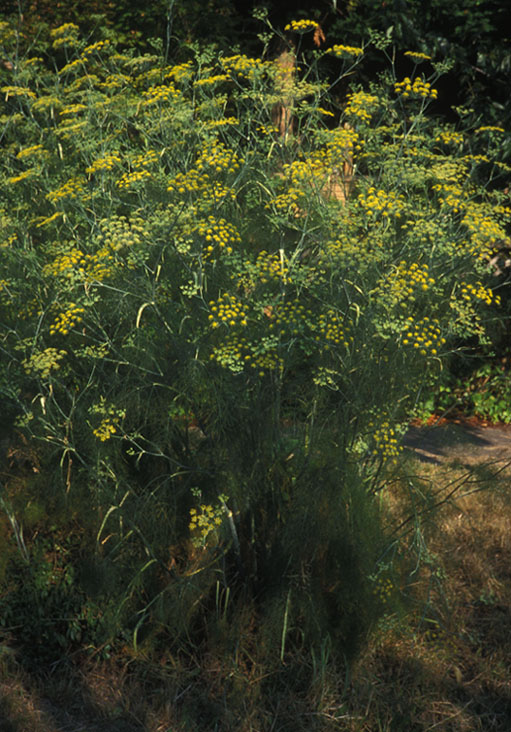
|
| Fennel; Foeniculum vulgare Mill. |
Carrot Family; UMBELLIFERÆ (APIACEÆ)
|
| Few culinary herbs, if any, rival Fennel for strength. Both as a food flavoring and as a plant in the ground it bursts with energy!
Ruining a stew with too much fennel-seed is easy. Fennel left unguarded can devour your garden. But it is a warm, sweet ferny plant we all
should know, whether or not we enjoy its rich licorice flavor. |
| It comes from south Europe and western Asia. Now it is naturalized over much of the globe. If we must have weeds, let them be
like Fennel! In the Language of Flowers its meaning is "worthy of all praise." |
| Many people know the name but are unsure about the plant's appearance. The seeds, after all, are easily purchased from spice
racks, along with the seeds or ground leaves of some of its cousins: Anise, Caraway, Coriander, Dill, Lovage, and Parsley. Still more
relatives, used fresh mostly, are Angelica, Chervil and Sweet Cicely. All nine of these umbelliferous herbs can reseed in garden settings, but
none approach Fennel for vigor, persistence, and robustness. Parsley is about as persistent, but is a mere annual of middling size. Fennel
alone straddles with aplomb the spheres of cultivated herbs and wild weedy plants. |
| Sometimes people see and smell wild Fennel, but don't know it by name. They call it "Wild Anise," "Wild Dill" or "Wild
Licorice." It is fairly common in sunny fields, meadows, vacant lots, roadsides and railroad tracks. Despite its ability to thrive unattended by
humans, it is not a serious weed pest. It is instead best regarded as a garden plant that grows wild. As such it is in that dear category or class I
call common wild edible and useful plants to know. |
| Fennel is anchored by deep, large white taproots that are amazingly difficult to dig up except when young. Dislodging an old
clump can bend easily the tines of garden forks. In spring, a dense plume of wispy threadlike foliage of the purest green of any, surges up
from the roots, shooting higher and higher. By July the plant is ready to bloom, with tall cane-like stems, jointed and smooth like
bamboo. Conspicuous, pale, clasping leafstalks cover the tall stems. The topmost yellow flowers wave 10 feet from the soil (12 to 15 feet in
California sometimes!). |
| The overall appearance of the blooming Fennel is of delicate, ferny exuberance. The air is sweet with its licorice-like scent.
Insects drink the tiny drops of floral nectar. The yellow flowers give way to green seeds, an exquisite crunchy nibble before they turn dry,
brown and hard in late summer. The plant blooms into September, sometimes into October. Then it turns rangy, yellowish and worse as
winter becomes assertive. But even as the top dies down, the roots send forth fresh greenery. Gardeners or wild-food pickers can enjoy fresh
Fennel leaves any month. The ferny foliage is excellent eaten raw as is, added to salads or sandwiches, or chopped and used in cooking. The
young roots can be unearthed and eaten. The tender flowerbuds, like the flowers and seeds, are edible. You can use the seeds to flavor
liqueurs, candies, brandy, ice cream or whatever. The oil can be used in perfumes, soaps and medicines. The odor attracts fish. |
| Merely saying Fennel is edible does injustice to the herb. It is delicious and healthy! Few green vegetables are so good for you.
Its catalog of medicinal attributes includes: aromatic, carminative, diuretic, stimulant, and stomachic (meaning in everyday words that
Fennel is an ideal plant for digestion). If you find the flavor too powerful, try growing Florence Fennel. This is a variety with enormously
swollen leafstalks, making a squat, bulbous plant. Chopping a perfected specimen into a salad makes for supreme pleasure. |
Bronze Fennel is a well-named ornamental that can be eaten like the ordinary green plant. Giant Fennel is the genus
Ferula, both rare and less useful. Dog Fennel is a chamomile-like weed of the sunflower family.
|
Originally published as the Seattle Tilth newsletter Weed of the Month in January 1991, along with an illustration drawn by Annie Figliola.
Back |
|
|

